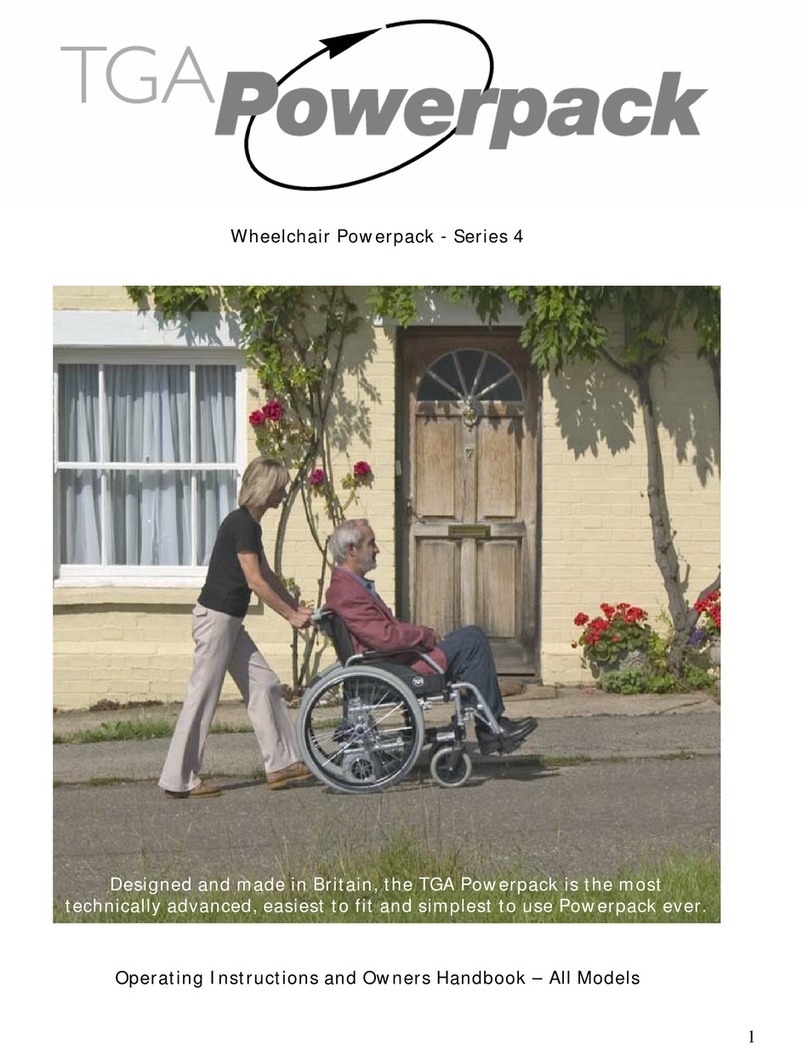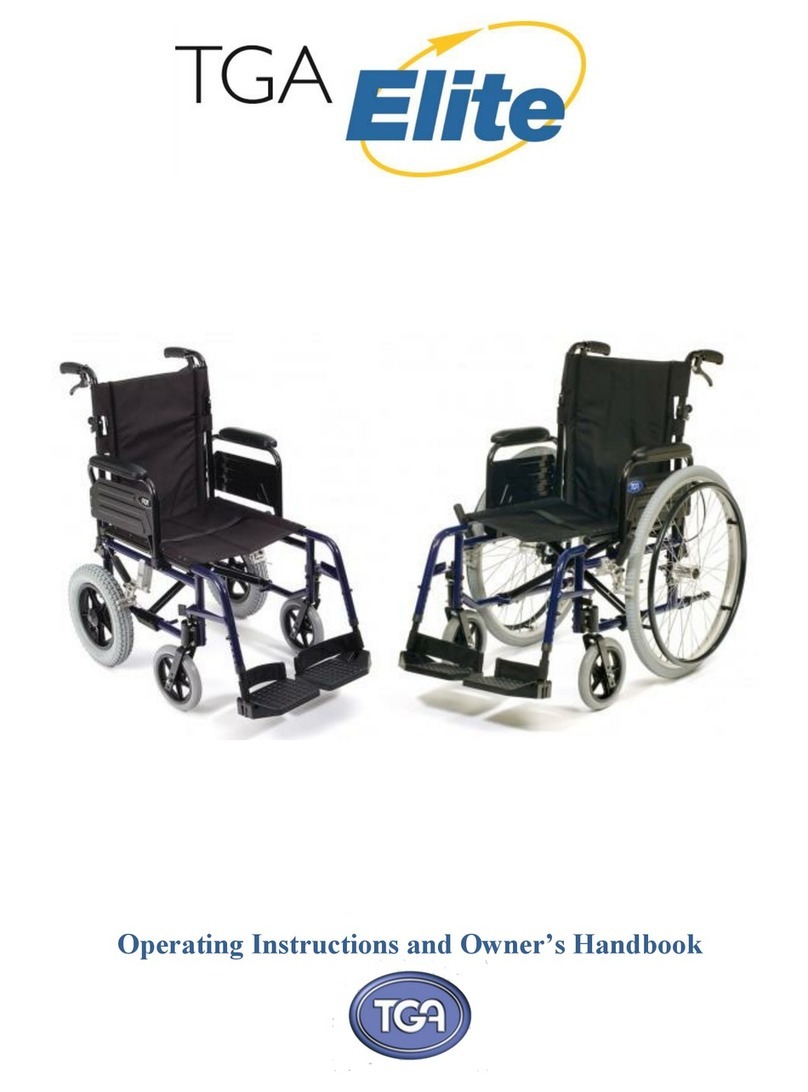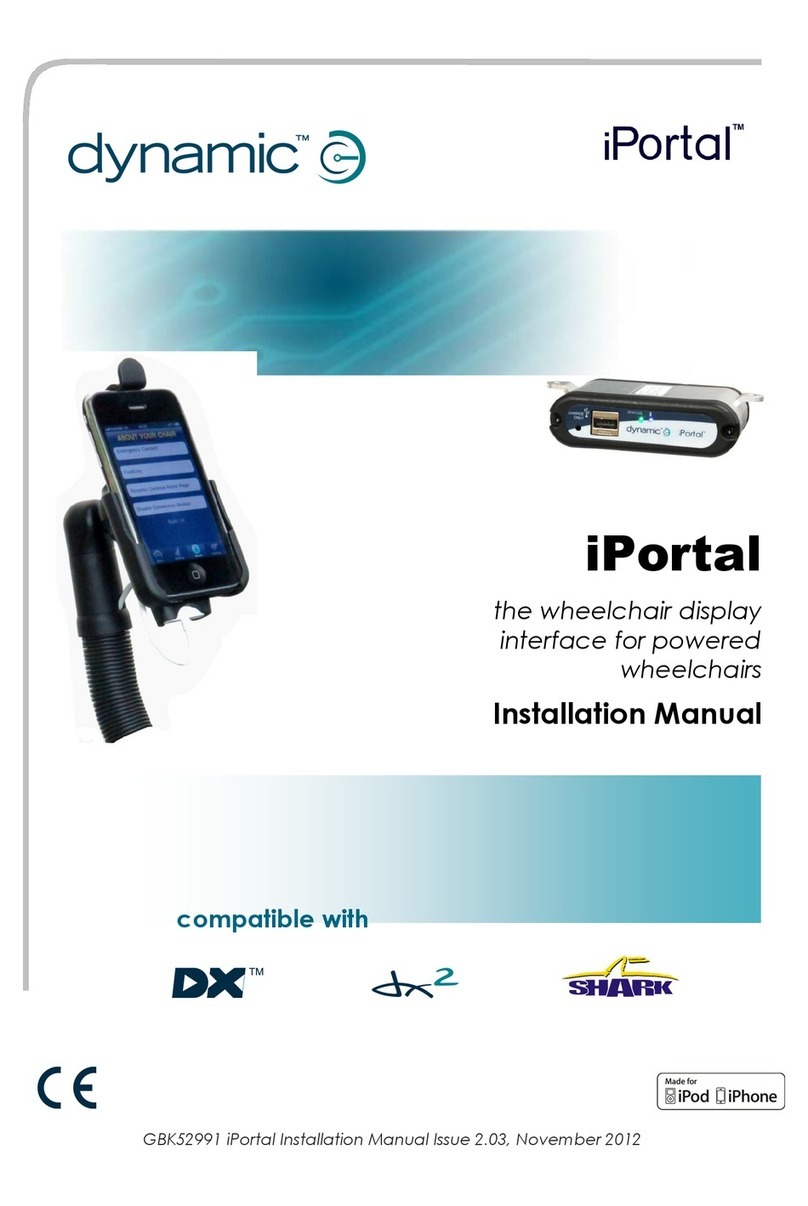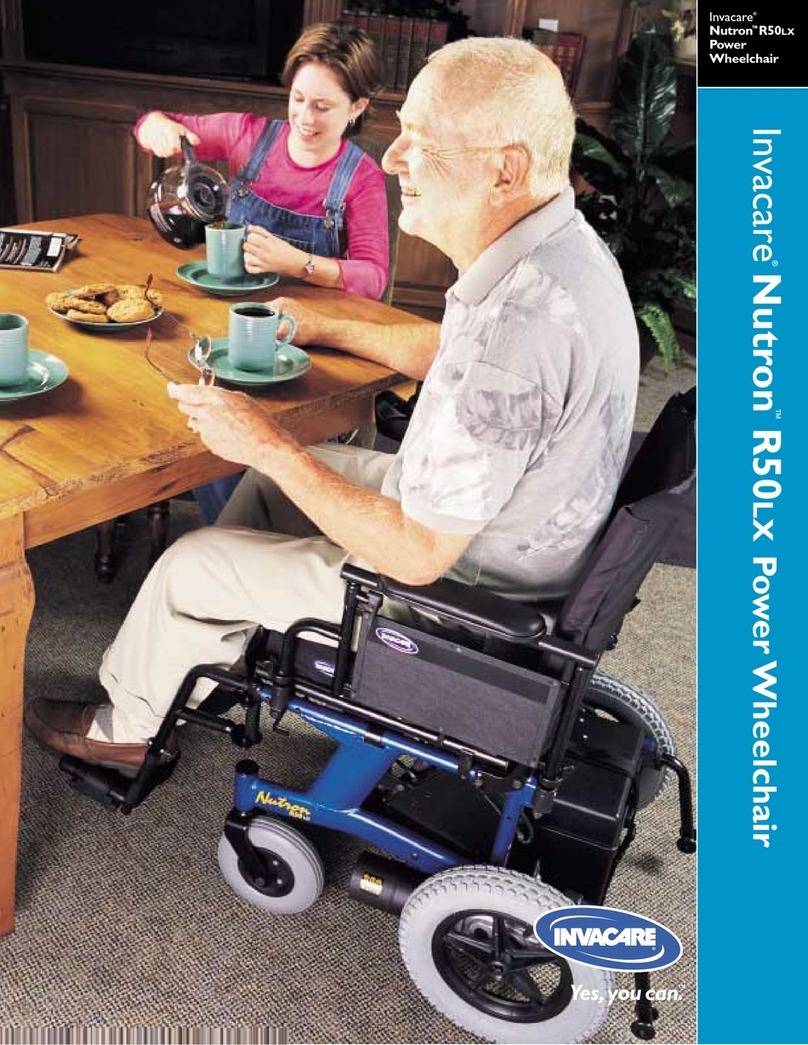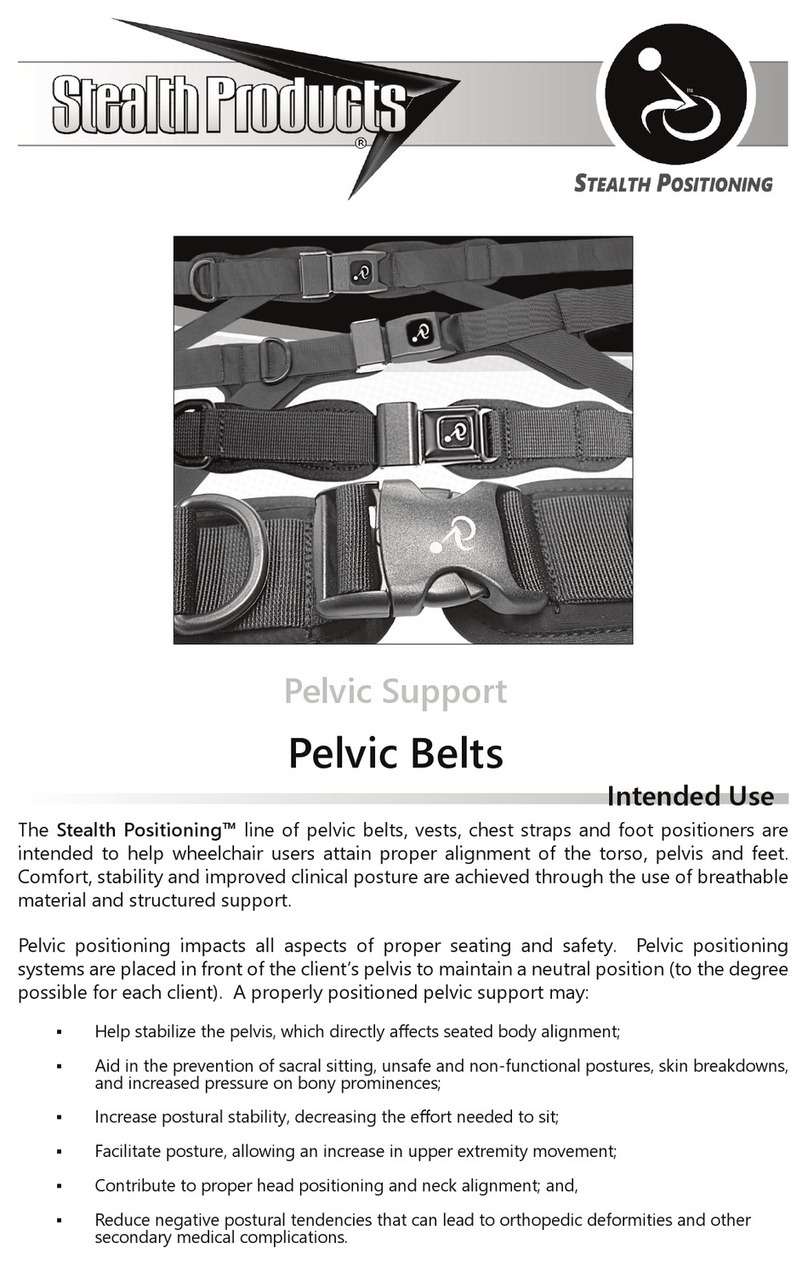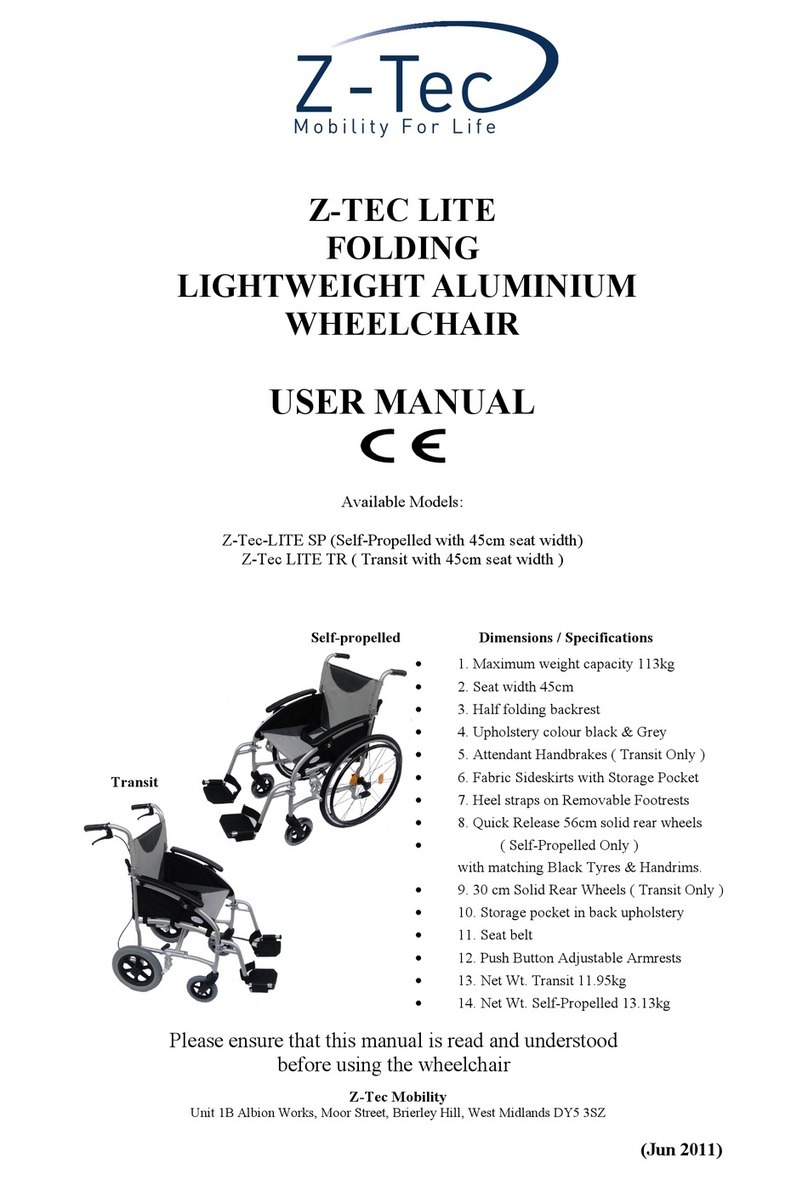TGA Minimo Autofold Quick start guide

MINIMO AUTOFOLD
Operating Instructions
and Owner’s Handbook

Introduction page 3
Product overview page 3
Your scooter controls page 4
Driving your scooter page 5
Folding & unfolding your scooter (battery tted) page 6
Folding & unfolding your scooter (battery removed) page 7
Adjusting your tiller page 7
Removing your battery pack page 7
Removing your seat page 7
Adjusting your arm rests page 8
Charging your scooter page 8
Parking brake release page 9
Maintenance page 9
Troubleshooting page 10
Tips for scooter users page 10
Disposal of product, batteries and charger page 10
Technical specications page 10
Contents
23

Welcome to the TGA family!
This manual provides important operational and maintenance information. Please take the
time to read in full before venturing out on your new Minimo Autofold.
Important safety related issues will be drawn to your attention with this warning symbol:
WARNING!
Please keep this manual in a safe place for future reference.
Introduction to your Minimo Autofold
Product overview
Your Minimo Autofold is a class 2 mobility scooter and intended for indoor or outdoor use
but is not road legal. It is designed to fold automatically in order to t in your car boot
making it ideal for trips to your local town and shops. The scooter is designed to be used
by a range of clients whose mobility has been reduced or removed by a disability or chronic
illness. It is capable of up to 4 mph, can climb 3-degree slopes and negotiate obstacles up to
6 cm high (see Technical Specications).
The design accommodates a single user. It is a lithium battery powered four-wheeled
scooter capable of a 4 mph maximum speed with the intention of it being used as a wheeled
conveyance to enhance the mobility of a person with a maximum mass of 18 stone (115 kg).
Suitability is dependent upon the degree and nature of disability and should be determined
through a thorough risk assessment carried out by a qualied medical professional, TGA
representative or approved dealer. This scooter can be suitable for assisting in rehabilitation,
restoring independence and in some instances long-term alleviation of disabilities and
chronic illnesses.
Consideration must be given at point of prescription to required usage with regard to your
capabilities and the environment and terrain on which the product will be used. Your dealer
must provide you with instruction around how to operate your scooter safely before you can
independently operate your product. Consider initially operating the scooter under their
supervision until you feel condent to operate it independently.
The TGA Minimo, Minimo Plus 4 and Minimo Autofold are imported into the EU by TGA
Mobility Ltd and are placed on the EU market, marked as a Medical Device, and complies with
the Essential Requirements of the Medical Device Directive 93/42/EEC.
Testing carried out indicates that if this product is used in line with this user handbook
and maintained in accordance with a service plan, the product life cycle is ve years. With
ongoing maintenance and care it may exceed ve years in life.
Items included with your Minimo Autofold
• Charger power lead
• 2 battery keys
• 2 RFID fey fobs
• Remote battery connection lead
• Charger
23

F
E G
C
A
B
I
D
H
Your scooter controls
A. Horn – Press the button to sound your horn.
B. Key Fob – Press the power button on the
Minimo display panel until the light surrounding
the button illuminates red, then swipe the
key fob over this button to put the scooter
into ‘driving mode’ (indicated by the light
changing to blue). Always keep the fob with you
when driving.
C. Battery Condition Indicator – When
your scooter is switched on, the lights on the
indicator will show the level of battery life. As
the battery is used, the lights will individually
extinguish from green to red – all lights on
meaning fully charged, only red lights showing
meaning your battery needs to be recharged.
For more information see the ‘Charging Your
Scooter’ section.
D. Power Button – Press the power button to
wake up the system. When it shows red, it is
awaiting the command from the fob to go into
‘drive mode’ – which will turn this to blue. Press
again to switch the scooter off. (In the diagram
below, the power button is shown as a blue
circle, as it is hidden by the Key Fob).
E. Speed Adjuster – This allows you to pre-select
your desired maximum speed. Turn the adjuster
knob fully anti-clockwise for the lowest speed
and gradually rotate clockwise to increase your
maximum speed.
F. Throttle Control Levers – The throttle control
also adjusts the speed of your scooter. The further
you move the control lever the faster you will go.
To move forwards, pull the red right-hand lever
towards the handlebar. You can either pull the red
right hand lever or push the black left-hand lever).
To reverse, pull the black left-hand lever towards
the handlebar.
G. Hazard Light Button (located on the end
of the handlebar) – Press, release and wait ve
seconds. The front light and rear lights will ash.
H. Light Switch – The switch under the control
panel will operate the front and rear lights. Please
note the front day-running light will always remain
on while your scooter is in use. This switch will put
the front light on ‘full beam’.
I. Autofold Button (located on the end of the
handlebar) – When the scooter is turned off, press
the button and press on the foot pedal to start the
automatic folding process.
45

Driving your scooter
Before driving your scooter, make sure the
battery is fully charged and check the tyres
do not appear to be soft (see Maintenance
section for details of monthly checks and
tyre pressures). Do not press the ‘on’
button before sitting on your scooter. When
transferring onto your scooter from a seated
position, lower the armrest to give easy
access to the seat. Always ensure both your
scooter and the chair/wheelchair you are
transferring from are stable and have wheels
locked/brakes applied. When comfortably
sat, ensure that the seat is secure. Ensure
the armrests are in the correct position.
Set your speed to low, hold the tiller
handlebars with both hands and gently
apply pressure to the throttle control lever
to move forwards. The more pressure you
apply to the lever, the faster you will go.
Remember to always come to a stop before
changing from forward to reverse.
Releasing the throttle control lever
automatically operates the motor brake
to slow down your scooter to a stop.
Once stopped, the parking brake will
automatically engage.
Use the tiller to steer your scooter left and
right. Simply move your left hand towards
you to steer left and your right hand
towards you to turn right. Always slow down
before turning.
To reverse, pull the black left-hand throttle
control lever towards the handlebar. The
speed in reverse is reduced automatically
for safety; while reversing your scooter will
‘beep’. Before reversing, check the area
behind you is clear, and continue to check
while reversing.
To negotiate kerbs, you should always
approach as head-on, (square), as possible.
If you are going up, select a low speed
setting then drive until both front and back
wheels are on the pavement. If going down,
proceed slowly until on the road, then
switch to a suitable higher speed to cross
the road safely.
WARNING!
When driving your Minimo Autofold
over surfaces that could be slippery,
slow down and take extra care. This
includes, but is not limited to, icy
surfaces, frost covered surfaces,
surfaces covered in leaves and wet
surfaces. Attempting to turn on a
slippery surface without slowing down
could result in your scooter continuing
on in the same direction and not
turning, especially when travelling
down an incline.
WARNING!
You should be especially vigilant when
traversing across a slope or gradient.
When traversing a slope, your centre
of gravity changes so there is more
danger of tipping sideways. You can
reduce any risk to yourself by travelling
slowly. Be aware that any additional
loads being carried such as shopping
bags, can also affect the centre of
gravity of you and your scooter.
WARNING!
The Minimo Autofold will automatically
slow down when turning corners.
However, you should ensure you take
extra care when turning, especially
when changing direction from moving
forward in a straight line.
Watch your battery condition indicator.
The distance you can travel depends
on many factors. Range is inuenced by
many environmental conditions – hills
will substantially decrease the range,
for example. Establish what you can
obtain around your locality by gradually
increasing the distance and checking
the battery indicators at the end of
each journey.
Should the battery run out before you get
home, there is a ‘free wheel’ mode that
will allow someone to push your scooter
home. This is operated via the parking
brake release. See the instructions label
at rear of your scooter. You must never
use free wheel mode with an occupant on
the seat.
45

Driving on the road
Your scooter is dened by the Department
for Transport as a class 2 mobility scooter
and therefore it is NOT road legal.
Driving inside shops and buildings
When inside, it is your responsibility to drive
slowly and safely and not damage your
surroundings or hurt other people.
Using the footpath – If you are on a scooter
you are no longer a pedestrian. You
must give way to pedestrians as per the
Highway Code.
In a crowded precinct, market area, or
footpath – It is your responsibility to ensure
you do not run into anyone or do any harm
with your scooter.
Portable Ramps
This scooter cannot be driven up portable
ramps exceeding the specied gradient.
Due to the nature of portable ramps, it is
recommended that the user dismount, and
the scooter is moved up the ramp by a
person with the strength and agility to be
able to fully manoeuvre the scooter safely
using the free wheel function.
WARNING! Watch out for:
• Children – they may run in front of
you.
• Elderly people – they may be unable
to quickly move aside to let you pass.
Give way.
• Disabled people on foot – they too
may be unable to move aside for you.
• People with visual problems or
impaired hearing – give them space
and time.
• Other scooter users.
WARNING! Transportation in Vehicles
This scooter is not suitable to use as
a seat in a vehicle. It has NOT been
crash tested. Users must transfer to
seating in the vehicle. The scooter must
be stowed safely in the vehicle, in a
luggage compartment or similar.
Folding
1. Fold the back of
the seat down and
the arms back (see
Adjusting Your Seat).
2. Press the power
button to turn the
scooter off.
3. Press the Autofold
button on the left-
hand side of the
handlebar. It will glow
orange for around
ve seconds. Within
this time, push down
on the foot pedal for
around three seconds
to start the automatic
folding process.
4. Once folded you
can then lift your
scooter using the
handle at the rear
and stand it on its
front wheels to move
around in the folded
position.
Unfolding
To unfold your
Minimo Autofold,
simply press the
Autofold button until
it shows an orange
light and then press
on the foot pedal for
around three seconds.
The scooter will then
unfold automatically.
Folding & unfolding your
scooter (with the battery fitted)
To fold your scooter in order to put it into
a car boot, stand it up or store it, follow
these steps:
67

If you’d like to adjust
the height of your
tiller, simply turn the
adjustment wheel anti-
clockwise until the top
part of the tiller moves
freely up and down.
Then just move the
top half of the tiller to
the height you would
like and tighten the
adjustment wheel by
turning it clockwise
until tight.
To remove the battery
pack, rst ensure the
pack is unlocked by
inserting the key into
the pack and turning
it 90° anti-clockwise
to the unlock position.
Then simply lift the
pack up using the
handle provided.
To remove your seat,
follow these two
simplesteps:
1. Pull and rotate
the red circular knob
located under the
seat so that it is
locked open.
2. Slide the seat
forwards slightly and lift
away from the base.
Adjusting your tiller
Removing your battery pack
Removing your seat
WARNING!
Always ensure the seat is locked in
place before attempting to get on.
Failure to check this could result in
injury.
Folding & unfolding your
scooter (with the battery
removed)
You can fold and unfold your scooter with
the battery removed. This enables you to
charge your battery remotely from the
scooter or remove the battery in order
to travel on a plane. To fold and unfold
your Minimo Autofold with the battery
removed:
1. Remove the battery as explained on page
6, ‘Removing your Battery Pack’
2. Connect the remote battery connection
lead that was supplied with your scooter
to the charging socket on the top of the
battery, and to the charging socket on the
side of your scooter, ensuring that they are
rmly located.
3. Carry out the same folding and unfolding
procedure, detailed previously as if the
battery was located on the scooter.
4. After folding or unfolding your scooter
with the battery removed, you must remove
the remote battery connection lead and
store it safely. Ret the battery in order to
drive your scooter.
WARNING!
Never drive your scooter with the
battery removed and connected to the
side charging socket.
WARNING!
• Always take care when folding and
unfolding your scooter that your hands
and ngers are clear of moving parts.
• The automatic folding process may
stop if an obstruction is preventing it
to fold fully.
To replace the seat reverse these steps.
67

Only use the charger supplied with your
scooter as other makes of chargers have
not been tested and may permanently
damage your batteries. Your battery charger
is designed and tested for use with your
scooter, so it may not be suitable for others.
The battery can be charged either tted to
your scooter or when removed, remotely,
from your scooter. When charging remotely,
please follow the instructions below starting
at number 2. To remove the battery see
‘Removing your Battery Pack’ on page 6.
To charge your batteries, follow these
simple steps.
1. Switch OFF your scooter.
2. Ensure the charger power lead is rmly
plugged into the body of the charger.
3. Plug the round plug on the charger
lead into the socket located on the battery
pack. Plugging the charger in automatically
cuts all power to the electronics so your
scooter cannot be driven. Alternatively, you
can plug the charger lead into the socket
located on the side of the Minimo Autofold
– particularly useful when the scooter
is folded.
4. Push the plug from the mains power lead
into a suitable wall outlet and switch on.
5. A green light will ash before turning
red, to indicate the battery is charging. The
green light will come on when your battery
is fully charged.
6. When your battery reaches its maximum
charged state, stop charging. Do not charge
for over 24 hours.
7. Although to get out of trouble the
batteries can be put on charge for a short
period of time, it is always best to go
through a complete charge cycle each time.
Excessive short period charging will be
detrimental to battery life.
8. Depending on the depth of the discharge,
the minimum time taken to recharge
serviceable batteries fully will vary between 4
and 10 hours. Please note that this time
Charging your scooter
Your scooter
has both height
adjustable and
rotating armrests.
To adjust the height
of your armrests,
follow these two
simple steps:
1. Press the silver
button located
halfway up
either armrest.
2. Slide the armrest
to a suitable position
and height and
release the silver
button. The armrest
will locate into
the nearest pre-
set position when
you apply gentle
downward pressure.
To rotate the
armrests, follow
these two simple
steps:
1 Press the silver
button located
at the bottom of
the armrest.
2 Rotate the armrest
backwards 90 degrees
until it locks in place.
To rotate the armrest
forwards simply
reverse these steps.
Adjusting your arm rests
89

Your scooter is tted with a manual parking
brake release. This is located at the rear of
your scooter just above the right-hand rear
wheel. The back position is normal use, pushed
forwards releases the brake and allows your
scooter to be pushed, (free wheel mode).
There will be no power to drive when the brake
is in this position, however when switched on
the battery condition indicator lights will ash
indicating a fault mode.
We recommend that your scooter has an
annual service and maintenance check
by either TGA or an approved mobility
specialist. There are, however, a few tips you
can follow yourself to keep your scooter in
good condition.
Keep all components clean and dry.
Keep your tyres inated according to the
technical specication. Low tyre pressure
will degrade your scooter’s performance,
so it is very important that you check them
frequently.
Check your tyres for wear and replace
them as soon as there is any sign of
excessive wear.
Your scooter uses lithium maintenance free
batteries which are leak-proof regardless of
their position, so charging the battery is the
only maintenance required. DO NOT leave
the batteries at though, charge them
every
4 weeks if your scooter is being stored or
not in use.
Check any accessible electrical cable
connectors are fully home and secure.
Battery replacement is dependent upon
use. When your batteries lose power too
quickly, it is likely they need replacing. If
you want to change the batteries inside
the battery pack yourself, installation
instructions are included with the
replacement batteries from TGA.
Make sure all repairs relating to electrical
or mechanical components are carried out
by TGA or an approved mobility specialist
only.
Do not apply oil or grease to any
components. Sealed bearings and nylon
bushes eliminate the need for lubrication.
Parking brake release
Maintenance
WARNING!
All TGA lithium battery packs contain a
temperature sensor. When this sensor
records a temperature of 10°C or lower,
the internal circuit board will stop the
battery charger from working in order
to protect the battery cells. Once the
battery pack reaches a temperature of
approximately 20°C it will then allow
the charger to start working again. This
is only relevant if the pack drops below
10°C, so long as the battery pack is
stored and remains above 10°C then the
charger should work as normal; standard
room temperature is sufcient.
WARNING!
Never sit on your scooter with the
parking brake released. The scooter
will have no effective braking system
when in free wheel and must only
be used to manoeuvre the product
unoccupied.
WARNING!
•
DO NOT smoke or use a naked ame
while your batteries are being charged.
•
DO NOT use the charger if it has
received a sharp blow, been dropped or
otherwise misused in any way.
•
DO NOT dismantle your charger.
•
DO NOT leave your charger plugged
into your scooter with your charger
switched off as this may discharge your
batteries.
•
For a complete charge – do not switch
off, unplug or interrupt the recharge
cycle until it has completed.
may increase as batteries get older. During
periods without use it is necessary to charge the
batteries every 4 weeks.
WARNING!
Never operate the manual parking brake
release lever when your scooter is on a
slope.
89

Seat Upholstery
You can use a damp cloth and a little soap
to keep your seat looking good. Do not use
abrasive cleaning materials as this will damage
the coating of your seat. Upholstery can also be
damaged by chemicals so do not over apply.
Ultraviolet light can also reduce the life of the
material coating your seat.
Bodywork
You can clean the plastic bodywork of your
scooter by lightly washing it with clean, soapy
water. Car polish can be used to keep the paint
and bodywork in pristine condition. Do not use
abrasive cleaners or strong detergents as this
will fade the colour. Do not pressure wash.
Parking Brake
You can check if the parking brake is functioning
correctly by testing if you can push your scooter
when it is switched off (or switched on with the
speed control throttle in the neutral position
and the parking brake lever in the rear/drive
position). If your scooter can be pushed as
described, the motor brake may be faulty.
Troubleshooting
Tips for scooter users
If your scooter does not start, check the
following:
Make sure the ‘on’ button has been pushed
and the blue light is showing. If it is then the
battery condition indicator will be displayed, if
it is showing empty then recharge batteries.
Check parking brake is released
If the battery condition indicator fails to
operate when the scooter is on, check the
following:
Make sure your battery charger is not plugged
in to the scooter, this will prevent your scooter
driving.
Check parking brake is released
Check the battery pack connection
If your scooter will not charge, check the
following:
Check the lights on your battery charger are
on and that the charger is plugged into a
working wall socket.
Check your battery charger is connected to
your Minimo Autofold charge socket correctly
Your Minimo Autofold is designated as a class
2 scooter, which is a 4 mph pavement scooter
and can only legally be used on the road
when either crossing over or because there
are no footpaths.
Class 2 scooters must not be driven on dual
carriageways, motorways, bus lanes or cycle
tracks.
Insurance
There is no legal requirement for insurance,
but TGA advise to have cover for re and theft,
accidental and malicious damage and third-
party damages. For more information call TGA.
WARNING!
If the above is the case, do not use your
scooter and contact TGA or an approved
mobility specialist.
You can also test the motor braking when
driving your scooter. If you let go of the
throttle control lever it should lose speed
very quickly. If you notice a change in the
normal stopping time/distance you should
contact TGA or an approved mobility
specialist.
• DO NOT operate your scooter in
extreme weather conditions, i.e. heavy
rain.
• DO NOT drive through deep water.
This could damage the main electronic
controller, or other electronics.
• DO NOT store your scooter in damp
conditions. This may affect the
electronics if left for long periods of time
• DO NOT hose down or pressure wash
your scooter. Water could be forced into
the electronics
and cause permanent damage.
WARNING!
If you nd for any reason your scooter
does not reduce speed when you let go of
the speed control lever, press the power
button to stop. This operation should only
be carried out as an emergency.
10 11

Length 97 cm
Width 53 cm
Folded Dimensions 83 x 53 x 47 cm
Seat Depth 35 cm
Total Weight 27.5 kg (61 lbs)
Wheel & Tyre Size front 17 x 4 cm
Wheel & Tyre Size rear 22 x 7 cm (2.80/2.50-4)
Battery 24v 11.5Ah (up to 25v)
Motor 4-pole 270 watt
Controller Dynamic controller 50
Charger 2.5 amp
Max Speed 4 mph (6 kmh)
Approximate Range up to 10 miles (15 km)
Max Carry Capacity 115 kg (18 stone)
Max Gradient 3 degree
Ground Clearance 6 cm
Vehicle Class 2
Tyre Pressure 25psi front, 30psi rear
Operating temperature -20°C to +40°C*
Storage temperature range -20°C to +40°C
*At extreme low temperatures, the batteries may freeze
and your scooter will be unable to operate. In extreme high
temperatures, it may operate at slower speeds due to a safety
feature.
Disposal of product, batteries
and charger
Technical specifications
Carrying Loads
Do not overload. It may make your scooter
unstable and reduce its range. Place heavy
loads inboard – in the middle – not behind the
back wheel which can lighten the steering or
can cause the front end to lift off the road on a
bump, and not at the front which might make
steering heavy. See maximum weight capacity
in the specications.
Airline Checking
11.5Ah lithium batteries are permitted on
aeroplanes. Airline personnel may insist
on removing the battery cover to verify its
contents. It is important to check with the
airline before travelling. An airline compliance
certicate is available from TGA. Due to
circumstances out of TGA’s control, it is not
possible to board an aeroplane with a lithium
battery exceeding 11.5Ah. This is due to an
instruction/information provided by the Civil
Aviation Authority. The Minimo Autofold
folding scooter comes complete with a 11.5Ah
battery and therefore can be transported on
aeroplanes.
Product Options and Accessories
Listed on the TGA Mobility Ltd. website,
(www.tgamobility.co.uk), are any optional
specications for your product. The website
also shows available accessories and spares
with guidance around which products the
accessories are intended to t.
Warranty
Conditions of warranty will be detailed on the
documentation supplied at the time of ordering
/ supplied with your new scooter. Consumable
components such as tyres, light bulbs, fuses,
brake pads, seat cushions and motor brushes,
are excluded from warranty.
The symbols shown below mean that in
accordance with local laws and regulations your
product should be disposed of separately from
household waste.
When this product reaches the end of its life,
take it to the local collection point designated
by your local authority. Or return it to TGA for
recycling in accordance with UK Environment
Agency regulations. The separate collection and
recycling of your product at the time of disposal
will help conserve natural resources and ensure
that it is recycled in a manner that protects
the environment.
NOTE: Ensure you are the legal owner of the
product prior to arranging for the product
disposal in accordance with the above.
Breakdown & Recovery Service
Again, not a requirement but a very good idea
to enable you have total peace of mind.
Mobile Phone
It is strongly recommended you carry a mobile.
phone at all times while out on the scooter in
the possible event of a breakdown, accident or
health-related issue.
10 11

TGA Mobility Ltd
Woodhall Business Park, Sudbury, Suffolk, CO10
1WH
Tel: 01787 882244
Fax: 01787 882248
Web: www.tgamobility.co.uk
Email: info@tgamobility.co.uk
INS25 v4
TGA Mobility Ltd reserves the right to change specification
and/or prices without prior notification or warning
Other manuals for Minimo Autofold
1
Table of contents
Other TGA Wheelchair manuals
Popular Wheelchair manuals by other brands

Sunrise Medical
Sunrise Medical QUICKIE SOPUR Nitrum Directions for use

Sunrise Medical
Sunrise Medical Breezy Ultra 4 Brochure & specs
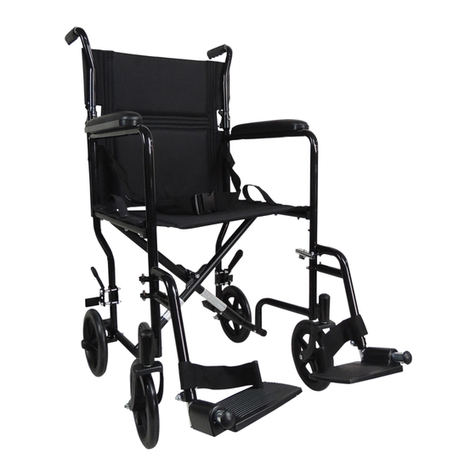
aidapt
aidapt VA171 Assembly and operating instructions
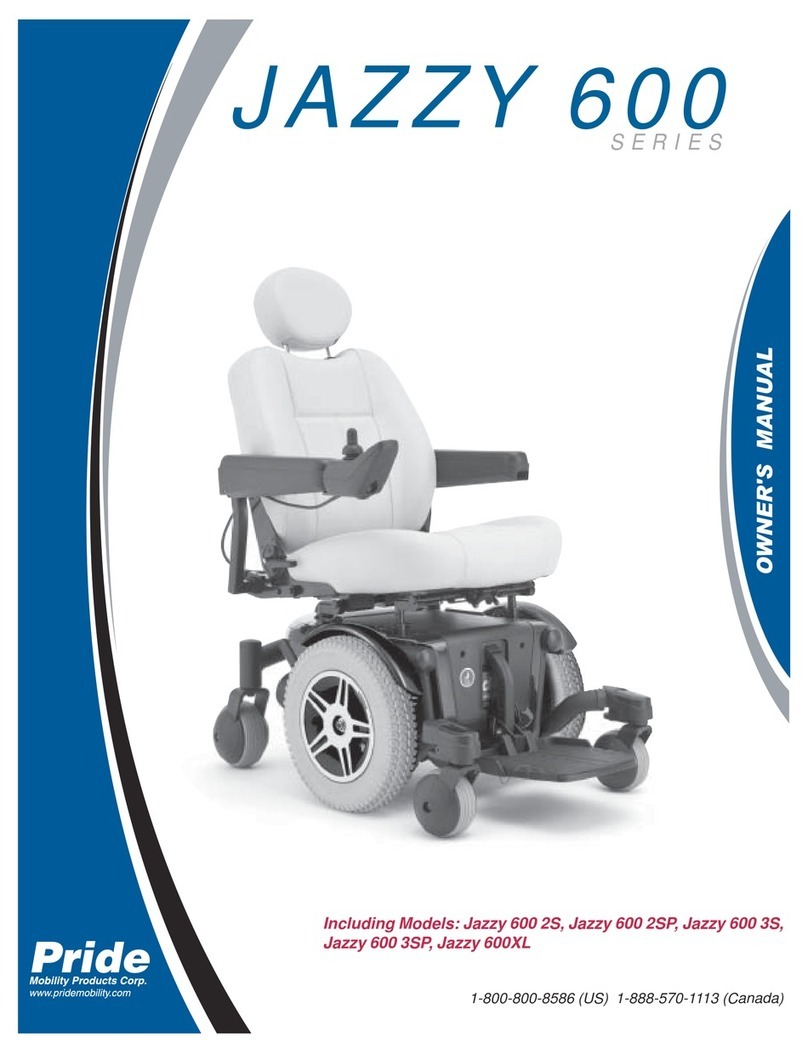
Pride
Pride Jazzy 600 2S owner's manual

DeVilbiss
DeVilbiss SEREN user manual
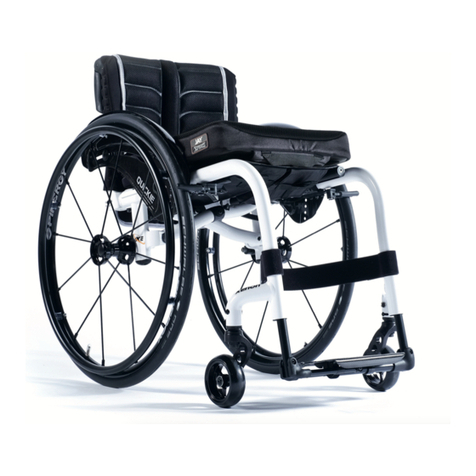
Sunrise Medical
Sunrise Medical SOPUR Xenon2 FF Directions for use
